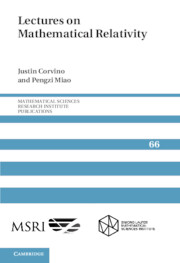Refine search
Actions for selected content:
4 results
Chapter 6 - Scalar curvature deformation and the Einstein constraint equations
-
- Book:
- Lectures on Mathematical Relativity
- Published online:
- 03 April 2025
- Print publication:
- 10 April 2025, pp 167-230
-
- Chapter
- Export citation
Chapter 7 - Asymptotically flat solutions of the Einstein constraint equations
-
- Book:
- Lectures on Mathematical Relativity
- Published online:
- 03 April 2025
- Print publication:
- 10 April 2025, pp 231-318
-
- Chapter
- Export citation
Chapter 5 - The Einstein constraint equations
-
- Book:
- Lectures on Mathematical Relativity
- Published online:
- 03 April 2025
- Print publication:
- 10 April 2025, pp 133-166
-
- Chapter
- Export citation

Lectures on Mathematical Relativity
-
- Published online:
- 03 April 2025
- Print publication:
- 10 April 2025
